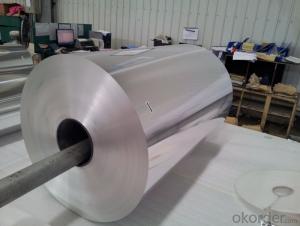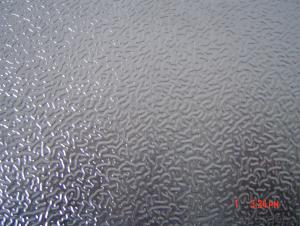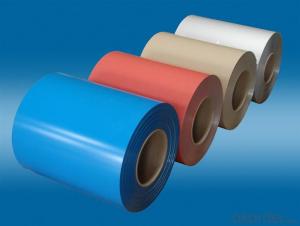Mill Finished Alloy 1235 Aluminium Foils
- Loading Port:
- Shanghai
- Payment Terms:
- TT OR LC
- Min Order Qty:
- 5 m.t.
- Supply Capability:
- 2000 m.t./month
OKorder Service Pledge
OKorder Financial Service
You Might Also Like
Item specifice
1. Structure of Mill Finished Alloy 1235 Aluminium Foils Description
Aluminum foil is widely used in medicine packaging, especially for Asian market. Because the good anti heat and anti wet specification, it's very good for packaging tablets and food. Noramlly for medicine packging, the quality should be higher than food packaging. For medicine packaging, we usually use direct casting quality, but for food packaging, we usually use continuous casting quality. All our aluminum foil for medicine packaging with soft temper is DC quality.
2. Specification of Mill Finished Alloy 1235 Aluminium Foils
Alloy 1235
Temper Soft / hard
Process DC
Thickness12mic~30mic
Width400mm~1650mm
Core ID76mm / 152mm
Chemical Composition
Alolly 8079% MaximumSi0.05~0.13Fe0.7~1.3Cu0.05Mn0.02Mg-Cr-Ni- Zn0.1Ti0.02Zr-Others0.15
Property
Tensile strength70~100MpaElongation3.5%~7%Bursting80~270Kpa
3. Advantage of Mill Finished Alloy 1235 Aluminium Foils
We've been specialized in aluminium foil for more than ten years, we know this product very well, and we have good finacial support from government. Meanwhile, 8079 with direct casting has better elongation and bursting data.
4. Feature of Mill Finished Alloy 1235 Aluminium Foils
Surfact Quality :
Be free from Oil Stain, Dent, Inclusion, Scratches, Stain, Oxide Dicoloration, Breaks, Corrosion, Roll Marks, Dirt Streaks and other defect which will interfere with use,
Mechenical Property:
Chemical Composite and Mechanical Property
5. Certificate of Mill Finished Alloy 1235 Aluminium Foils
SGS and ROHS(if client request, paid by client), MTC(plant provided), Certificate of Origin(FORM A, FORM E, CO), Bureau Veritas and SGS (if client request, paid by client), CIQS certificate
6. Image of Mill Finished Alloy 1235 Aluminium Foils
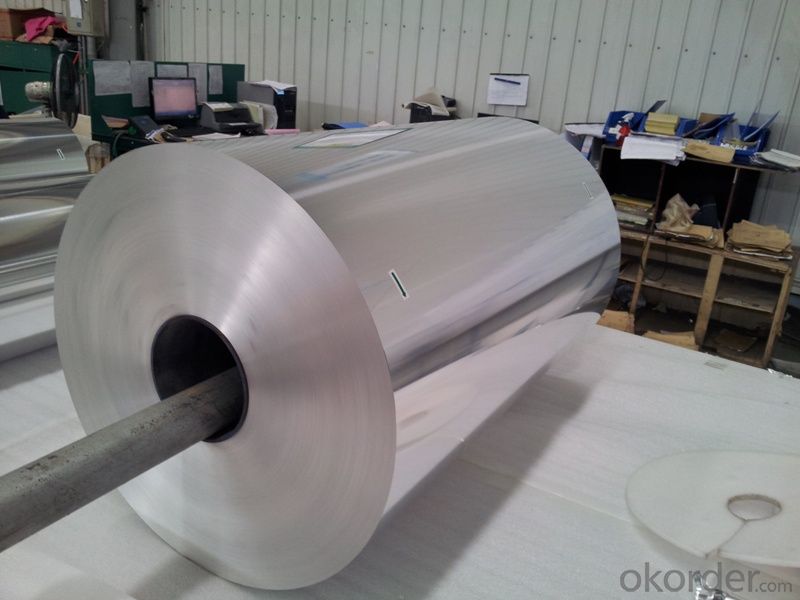

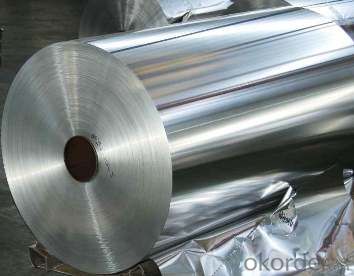
7. Package and shipping of Mill Finished Alloy 1235 Aluminium Foils
First, plastic cloth with drying agent inside; Second, Pearl Wool ; Third, wooden cases with dry agent , fumigation wooden pallets, aluminum surface could cover blue PVC film
8. FAQ
1) What is the delivery time?
Depends on actual order, around 30 to 40 days
2) What is the QC system:
We have QC staff of 20 persons and advanced equipment, each production is with MTC traced from Aluminum ingot lot.
3) What market do you mainly sell to?
Australia, America, Asia, Middle East, Western Europe, Africa etc
- Q:How do aluminum coils perform in saltwater environments?
- Aluminum coils perform well in saltwater environments due to their corrosion-resistant properties. The aluminum material forms a protective oxide layer that helps prevent rusting and deterioration caused by exposure to saltwater, making it a suitable choice for various applications in marine settings.
- Q:at what state is aluminum at room temperature?what are aluminums physical properties?what is aluminum obtained from?
- Aluminum okorder /
- Q:What are cold rolling aluminum coil and hot rolling aluminum coil? What are their features?
- If the rolling temperature is above the crystallization one, it is hot rolling, otherwise it is cold rolling.
- Q:Other than alloys. I'm trying to think of a way I can make an aluminum knife that will hold an edge. One group of researches say they used 60 metric tons of force to realign the molecular structure and give the metal strength equal to steel. I don't have a 60 ton press aha. Would heat treatment plus 10 tons of pressure repeated have a similar affect?
- Aluminum bronze is used commercially to make non-sparking knives. Why try to reinvent the wheel? I'm trying to think of a way I can make an aluminum knife that will hold an edge. You can strengthen aluminum by either cold working or heat treating a suitable alloy, but it will never be anything close to a good steel knife. Would heat treatment plus 10 tons of pressure repeated have a similar affect? No. Assuming that you are talking about the article linked to below: - you would have to duplicate the alloy process, even then you could only make a small thin sheet. They used a heat treatable alloy. The process involves torsional strain under 60 metric tons per square centimeter compression. How big a press do you think you would need for a knife size blank? And remember, you have to apply torsional cold work while compressing it. -Their results ( 1 gPA YS 5% elongation in a very thin sheet) don't look that great compared to a good knife steel. Or a good titanium knife.
- Q:Why does aluminum foil barely get hot in the oven, but catch fire in the microwave?
- It has to do with the resonance of the microwave radiation with the 'points' on the aluminium foil. We don't think of foil as having 'points'...to us it looks smooth. However, when the microwave bouce around in the oven, they find each and every uneven surface on the foil. In layman's terms, the microwaves 'collide', causing a build-up of charge and energy. You'll notice that many pre-packaged microwave meals contain a 'crisping' area on the cardboard that resembles aluminium. This is a specially treated foil that won't set up a resonance, but instead will concentrate the microwaves in a particular area, causing the food to cook much faster in a small, external area. The result: a nice, crispy shell on your otherwise limp and tasteless Hot Pocket! Enjoy!
- Q:What are the potential applications of coil-laminated aluminum coils?
- Coil-laminated aluminum coils have a wide range of potential applications in various industries. They can be used in the manufacturing of automotive parts, such as body panels and interior components, due to their lightweight yet durable nature. Additionally, they are suitable for building and construction purposes, including roofing, siding, and insulation, as they offer excellent corrosion resistance and thermal conductivity. Furthermore, coil-laminated aluminum coils find use in electrical industries for producing transformers, capacitors, and other electrical components due to their excellent electrical conductivity. Overall, their versatility and desirable properties make coil-laminated aluminum coils valuable in numerous applications across different sectors.
- Q:Are aluminum coils available in different colors?
- Yes, aluminum coils are available in different colors.
- Q:Can aluminum coils be used in the production of window frames?
- Indeed, window frames can be produced by utilizing aluminum coils. Aluminum, as a lightweight and robust substance, finds frequent application within the construction sector owing to its resistance to corrosion and impressive strength. Aluminum coils can be effortlessly molded into numerous configurations, including those suitable for window frames, thereby rendering them an optimal selection for the fabrication of windows. Furthermore, aluminum qualifies as a sustainable material that can be effortlessly recycled, thus establishing it as an eco-friendly alternative for window frame manufacturing.
- Q:How does the alloy composition affect the properties of aluminum coils?
- The alloy composition of aluminum coils has a significant impact on their properties. Aluminum is often alloyed with other elements such as copper, manganese, magnesium, and zinc to enhance specific characteristics. One of the key properties affected by the alloy composition is the strength of the aluminum coils. Copper and zinc alloys, such as the popular 6061 or 7075 aluminum alloys, are known for their high strength, making them suitable for structural applications. On the other hand, manganese and magnesium alloys, such as the 3003 or 5052 aluminum alloys, offer improved formability and are commonly used in the construction of automotive components or packaging materials. The alloy composition also affects the corrosion resistance of aluminum coils. For instance, the addition of magnesium in alloys like 5052 or 5083 enhances their resistance to corrosion in marine environments, making them ideal for boat building or other marine applications. Copper alloys, on the other hand, possess excellent resistance to atmospheric corrosion and are frequently utilized in outdoor structures or architectural applications. Another crucial property affected by the alloy composition is the thermal conductivity of aluminum coils. Copper alloys have high thermal conductivity, making them efficient for heat transfer applications like heat exchangers or radiators. Aluminum-magnesium alloys, such as 3003 or 3004, have lower thermal conductivity, making them suitable for applications where heat dissipation is desired, such as heat sinks in electronic devices. Furthermore, the alloy composition can impact the electrical conductivity of aluminum coils. Copper alloys, due to their high electrical conductivity, find applications in electrical wiring and conductors. However, aluminum-magnesium alloys, despite having lower electrical conductivity than copper, are still widely used for electrical transmission lines and overhead power cables due to their lightweight nature. In summary, the alloy composition of aluminum coils plays a crucial role in determining their properties. It affects the strength, corrosion resistance, thermal conductivity, and electrical conductivity of the coils, allowing them to be tailored for specific applications.
- Q:What are the different widths available for aluminum coils?
- The different widths available for aluminum coils range from narrow widths of around 3 inches to wider widths of up to 60 inches or more, depending on the specific requirements and applications.
1. Manufacturer Overview |
|
|---|---|
| Location | |
| Year Established | |
| Annual Output Value | |
| Main Markets | |
| Company Certifications | |
2. Manufacturer Certificates |
|
|---|---|
| a) Certification Name | |
| Range | |
| Reference | |
| Validity Period | |
3. Manufacturer Capability |
|
|---|---|
| a)Trade Capacity | |
| Nearest Port | |
| Export Percentage | |
| No.of Employees in Trade Department | |
| Language Spoken: | |
| b)Factory Information | |
| Factory Size: | |
| No. of Production Lines | |
| Contract Manufacturing | |
| Product Price Range | |
Send your message to us
Mill Finished Alloy 1235 Aluminium Foils
- Loading Port:
- Shanghai
- Payment Terms:
- TT OR LC
- Min Order Qty:
- 5 m.t.
- Supply Capability:
- 2000 m.t./month
OKorder Service Pledge
OKorder Financial Service
Similar products
New products
Hot products
Hot Searches
Related keywords
